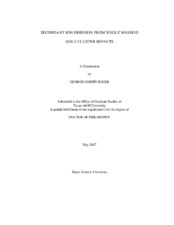| dc.description.abstract | Secondary ion mass spectrometry, SIMS, is one of the most versatile surface analytical techniques. The significant parameter determining the performance of SIMS is the secondary ion yield. Atomic projectiles, traditionally used in SIMS, are an inefficient method to desorb and generate secondary ions. The use of poly-atomic projectiles, such as (CsI)nCs, Au3, SF5 and C60, has been demonstrated to be an effective means to enhance secondary ion yields. Still larger secondary ion yields can be obtained with massive gold clusters, specifically Au4004+. Secondary ion yields from organic targets approach unity and are in excess of unity for selected inorganic targets. This dissertation is a first study of the secondary ion emission characteristics resulting from surface bombardment of keV Au400. The enhanced secondary ion yields from these massive clusters resulted in a need to detect isobaric secondary ions. An eight-anode detector was designed, built and implemented to study secondary ion emission resulting from massive projectile impacts. Secondary ion yield enhancements, resulting from use of the multi-anode detector, are reported along with secondary ion distributions for organic and inorganic targets. Au-adduct ions have been observed in mass spectra resulting form organic and inorganic targets bombarded by Au400. Data indicate that these adducts are a result of projectile/surface molecule interactions and not a product of Au implantation. Secondary ion yields of these adducts are reported. Although these adduct ion yields are an order of magnitude lower than the non-adduct ions, we have demonstrated their potential usefulness in analytical applications, such as examining surface homogeneity. Finally, these novel projectiles have been used to examine secondary ion emission from targets with different structural properties which have the same stoichiometry. In a comparative study, we have measured a significant difference in secondary ion emission and yields from the two systems, graphite and α-ZrP. Au400, at 136 keV, is effective in terms of secondary ion yield and secondary ion multiplicity enhancement. When used in the event-by-event bombardment/detection mode, the desorption volume has a diameter between 10-20 nm with and emission depth of approximately 5 nm, perturbing less than an attomole of analyte. | en |


